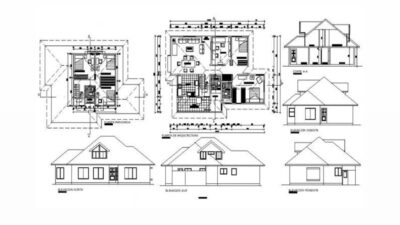Becoming an architect is a journey marked by artistic creativity, technical proficiency, and a deep understanding of design principles. The path to realizing this dream involves a structured process that intertwines rigorous education, practical experience, and professional accreditation.
Understanding the intricate pathways in Australia – akin to several other countries like the United Kingdom, Canada, and the USA – sets the stage for the aspiring architects.
Advanced Diploma in Building Design: A Starting Point
For those not meeting university entry criteria or seeking an alternative route, an Advanced Diploma in Building Design (Architectural) stands as a viable option. Spanning 2 years full-time or 3.5 – 4 years part-time, this course enhances skills and cultivates portfolios, paving the way for various career prospects within the architectural domain.
Undergraduate Bachelor’s Degree: The Initial Academic Step
High achievers with the required grades and university prerequisites can opt for a Bachelor’s course in architecture directly. This undergraduate degree spans three years, varying in nomenclature across universities and encompassing a diversified curriculum, from general disciplines to architectural specialization.
Master’s Degree: Delving Deeper into Architectural Education
The subsequent step involves pursuing a Master of Architecture, extending the educational voyage by an additional two years. Entry into this program typically necessitates meeting specific average marks from the initial degree or fulfilling foundational skill requirements, potentially extending to three years based on the individual’s academic trajectory.
Understanding the Registration Process
Architectural registration in Australia operates under state-specific legislation, aiming to safeguard the title and establish frameworks for practicing architects. The intricate process mandates registration within each state or territory of practice, emphasizing varying requirements across locations.
National Standard of Competency: A Necessity for Registration
The Architects Accreditation Council of Australia (AACA) oversees a National Standard of Competency, requiring practical experience post-graduation across diverse project types and construction processes. Demonstrating competency involves a rigorous three-part evaluation, including a logbook, written examination, and a panel interview.
Navigating the Registration Boards
Registration boards in each state or territory manage architectural accreditation. Once accredited by the AACA, architects must register in the specific state or territory they intend to practice, adhering to the respective regulations.
Registration Procedures in Other Countries
Similar registration processes exist globally, mandating specific educational qualifications, practical experiences, and subsequent registration. Resources provided by bodies like the Canadian Architectural Certification Board, National Council of Architectural Registration Boards in the USA, and the Architects Registration Board in the UK offer insights into respective registration frameworks.
Mapping the Journey: The Lengthy Route to Architectural Practice
The arduous trajectory to architectural practice spans approximately 8-10 years, encompassing study and registration processes. Opportunities for extended travel or practical experiences post-graduation can extend this duration, cementing architecture as a lifelong profession.
The Enduring Path of Architecture: A Profession of Continual Learning
Architecture transcends mere academic pursuits; it’s an ongoing journey of learning and adaptation. Despite its lengthy trajectory, architecture offers diverse pathways and rewarding experiences, requiring a dedicated, long-term commitment.
Unveiling the language of architectural design with Drawing Conventions
Essential Tips for Prospective Architecture Students
- Research & explore: Engage in hands-on exploration by visiting construction sites, attending workshops, and interacting with architects. This exposure provides invaluable insights into the diverse dimensions of the profession;
- Skill development: Prioritize honing foundational skills in drawing, design software, and model-making. Strong fundamentals lay the groundwork for success in architectural studies;
- Balancing Creativity & practicality: Embrace creativity while grounding designs in functionality, sustainability, and structural feasibility. Striking this balance is crucial in architectural education and practice;
- Mentorship & guidance: Seek mentorship from professors or practicing architects. Their guidance offers invaluable perspectives, enriching your understanding of architectural principles;
- Embrace constructive critique: Be open to receiving feedback and critique. Embracing constructive criticism fosters growth and refinement in design thinking;
- Time management: Architectural studies demand rigorous schedules. Develop effective time management skills to juggle design tasks, research, and coursework efficiently;
- Diverse exposure: Explore various architectural styles, cultural influences, and historical eras. Diverse exposure broadens design perspectives and enhances creative ideation;
- Practical experience: Seek internships or part-time roles in architectural firms. Practical exposure provides insights into real-world projects, construction processes, and client interactions;
- Networking: Establish connections within the architectural community. Networking events offer exposure to new ideas, potential job opportunities, and industry insights;
- Continuous learning: Stay updated with technological advancements, sustainability trends, and innovative design approaches. Continuous learning is essential in this evolving field.
Mastering these key points will lay a solid foundation for aspiring architects, enabling them to navigate their educational journey with confidence and readiness for the dynamic challenges of the architectural profession.
Conclusion
Embarking on the path to becoming an architect is an endeavor that combines artistry, technical expertise, and unwavering dedication. The insights shared here serve as guiding beacons for aspiring architects, illuminating the essential aspects vital for their educational and professional pursuits.
Embracing these tips fosters a proactive approach, ensuring a firm footing as they step into the captivating world of architecture, ready to shape innovative and sustainable built environments.











